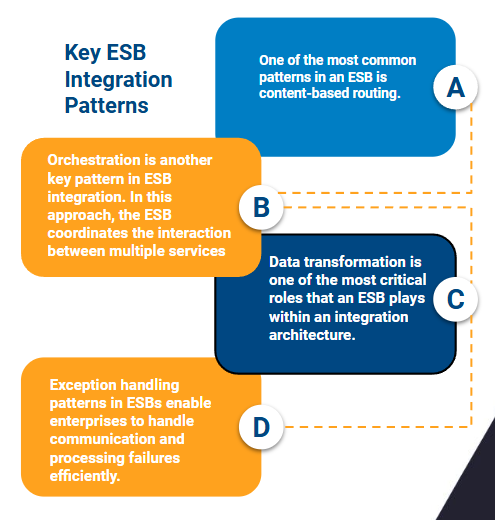
ESB (Enterprise Service Bus) integration patterns are fundamental in service-oriented architecture, allowing multiple applications to communicate and collaborate efficiently. As businesses evolve and adopt more distributed systems, data and service integration becomes essential to maintain operational consistency.
In this article, we will discuss the most commonly used ESB integration patterns today, their benefits, and how these can help businesses optimize their IT ecosystems.
Key ESB Integration Patterns
1. Content-Based Routing
One of the most common patterns in an ESB is content-based routing. In this pattern, the ESB evaluates the content of an incoming message and routes it to one or more backend services depending on its type or content. This is essential in environments where multiple services can handle different types of messages or data.
For example, in a business application, a message related to a purchase order may need to be routed to the ERP system, while a billing message may go to a financial system. The ESB acts as an “intelligent broker” that identifies the proper destination based on predefined rules.
This pattern is useful for reducing coupling between systems, as applications do not need to be directly connected to each other, and the ESB handles all the routing logic.

2. Service Orchestration
Orchestration is another key pattern in ESB integration. In this approach, the ESB coordinates the interaction between multiple services, organizing how distributed services should interact to fulfill an entire business process.
For example, for an online ordering process, an ESB may orchestrate communication between an inventory system, a payment system, and a shipping system. Each of these services is invoked in a defined sequence, and the ESB ensures that data flows correctly between the systems, also handling any errors that occur during the process.
This pattern is especially useful when complex workflows involving multiple services on different platforms are required to be executed.
3. Data Transformation
Data transformation is one of the most critical roles that an ESB plays within an integration architecture. In an enterprise environment, it is common for different systems to use different data formats (e.g., XML, JSON, or EDI). The ESB facilitates interoperability between these systems by transforming messages into the format required by each application.
For example, a billing system may send data in XML format, while a CRM system may need that data in JSON format. The ESB automatically transforms the messages, allowing the systems to work together without the need for changes to their source code.
4. Exception Handling and Retries
Error handling is an essential part of any integration architecture, and exception-handling patterns in ESBs allow companies to handle communication and processing failures efficiently. A common pattern is automatic retry when a request to a service fails, which can occur due to a temporary downtime of a backend system or network issues.
The ESB can also handle other exceptions, such as malformed data or timeouts, by sending notifications to administrators or invoking backup mechanisms to ensure business continuity.
5. Pub/sub
In the pub/sub pattern, a message producer (publisher) sends messages to a channel, and one or more consumers (subscribers) receive those messages. This pattern is useful when multiple systems need to receive the same information simultaneously.
For example, in an e-commerce platform, a notification service can advertise order-related events, such as a purchase confirmation or a package being shipped. Logistics, inventory, and customer service systems that subscribe to these events can receive real-time updates and act accordingly.
This approach decouples senders from receivers, allowing for more flexible and scalable integration.

Advantages of Implementing ESB Integration Patterns
Implementing an ESB and taking advantage of these integration patterns brings multiple benefits to organizations:
- Interoperability: Facilitates communication between heterogeneous applications, allowing different systems to talk to each other without the need for extensive modifications to their internal architectures.
- Scalability: Patterns such as pub/sub allow companies to scale their systems without creating a bottleneck in integration.
- Flexibility: Routing and orchestration patterns allow companies to change workflows without having to rewrite code in each system, speeding up response times to changes in business requirements.
- Simplified maintenance: By centralizing exception and error management, the ESB facilitates the identification and resolution of problems without directly affecting individual services.
- Cost reduction: By standardizing communications and facilitating the integration of existing systems, an ESB reduces the need for costly custom developments for the integration of new applications.
The Future of ESB Integration Patterns
In recent years, we have seen how the development of microservice-oriented architectures has influenced the evolution of ESB integration patterns. Although some experts argue that traditional ESBs can be replaced by API-based solutions and microservices, modern ESBs have adapted to support these new architectures. They now include advanced capabilities such as API management, the use of containers such as Docker, and integration with cloud-native platforms.
In fact, recent reports suggest that hybrid integration platforms that combine ESBs with API-centric approaches are gaining ground, allowing organizations to handle both traditional integrations and microservice-based workflows. This ensures that ESBs remain a valuable tool in enterprise integration.
ESB integration patterns continue to be a vital part of modern enterprise architecture, facilitating communication between distributed systems, handling data transformation, and ensuring that workflows run efficiently. If your company is looking to improve its integrations and optimize its processes, implementing an ESB with the right integration patterns can make all the difference in terms of agility and performance.
If you are interested in implementing or improving your ESB architecture, contact us to discuss how we can help you design and develop custom integration solutions for your business.
We recommend you on video


